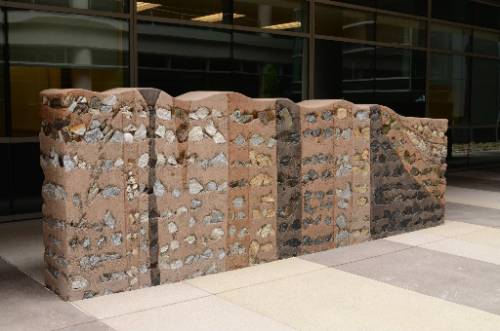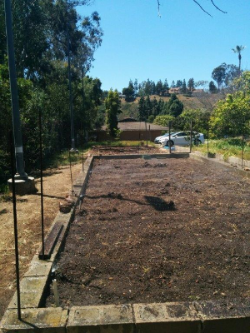Our Gardens
One of the most intriguing aspects about the $109 million Math and Science Complex at Mesa College is not part of the building at all. Learning gardens extend teaching and learning beyond the classroom walls to the outside of the facility. These specialty spaces were created by Mesa College faculty to enhance the teaching and learning experience:
- Located in the geographic center of Mesa College and alongside the central Promenade, three Microclimate Gardens representing the four regions of the world that share San Diego’s Mediterranean climate enhance student learning and showcase attractive water conservation landscaping.
- In the north central courtyard of the Math and Science Complex, a unique Geo-Garden provides a quiet study space and stone structures that depict the earth’s layers.
- In 2015, student club (TerraMesa), the college’s Environmental Stewardship Committee, and Facilities staff revived Mesa’s Organic Garden. Located in the grounds surrounding the P100/200 Buildings off the main campus at the corner of Marlesta Drive and Genesee Avenue, the organic garden offers an outdoor learning lab, a therapeutic space to connect with nature, and opportunities for transformative learning.
Geo-Garden

The Geo Garden features a central garden area and three six-foot tall stone wall segments depicting the earth’s layers. It consists of two main instructional components; including a series on the three free-standing, custom stratigraphic walls, and approximately two dozen boulder-sized rock specimens.
Geo Garden components illustrate important time and spatial relationships among various rock formations exposed throughout greater San Diego. Both coastal and inland rock units are represented, collectively spanning over 200 million years of geologic time. The stratigraphic walls consist of pigmented, stained concrete embedded with fragments from actual San Diego rock formations. Each wall is annotated with a descriptive steel plaque.
The rock specimens have been placed at strategic locations around the courtyard to illustrate common examples of all three rock types; including igneous, sedimentary, and metamorphic, as well as common geologic features such as mineral veins, faults, and fossilized sand dunes. Numerous common rock-forming minerals are also represented.
The Geo Garden represents the successful outcome of a public-private collaboration among Mesa Geology Professors Don Barrie and Ray Rector, a local concrete contractor (T.B. Penick & Sons), and a local landscape architectural firm (Wimmer, Yamada, and Caughey).

Classes that utilize the Geo-Garden include:
- GEOL 100: Physical Geology
- GEOL 101: Physical Geology Lab
- GEOL 104: Earth Science
- GEOL 111: The Earth through Time
- PHYN 100: Physical Science
Microclimate Gardens

The gardens surrounding the outer areas of the Math and Science Complex were designed to enhance student learning and to showcase attractive water conservation landscaping.
The gardens along the walkway between the Math and Science Building and the Learning Resource Center feature native regional plants typical of the shrub dominated ecosystems that define southern California, northern Baja, and other Mediterranean climates. There are shrubs, grasses, and flowering herbaceous plants. They are used to teach students to recognize native species and the features that help them survive so well in our low-water climate. Some of these native plants can be found planted at the rear of the building and the trees surrounding it are mostly coast live oak – one of the few trees that grow naturally in this region.
On the eastern sunny side facing the G Building along the campus Promenade, are plants from some of the other four regions of the world that share our Mediterranean climate with its mild temperatures, low precipitation, and winter rains. These plants share many features with our local species: small hard leaves, fuzzy leaves, and fragrant leaves. They provide an excellent example of convergent evolution.

On the east side, some northern California species and some African irises that can be harvested for use in labs are planted. In the back are various Mediterranean plants including fragrant lavender and a single cork oak tree, the bark of which is used as a renewable resource
Lastly, to the west of the G Building is a stunning desert garden filled with palo verde, cacti, local shrubs, and spring flowers; including our state flower: the California poppy. This area was planted by our own Mesa facilities staff long before the Math and Science building was built. It perfectly complements the rest of the California species and is also used in teaching.
Classes that utilize the Mediterranean Gardens include:
- BIOL 100 - Natural History & Environmental Biology
- BIOL 107 - General Biology
- BIOL 210B - Introduction to the Biological Sciences II
- BIOL 250 - Introduction to Botany
Organic Garden

The organic garden provides opportunities for transformative learning in the Mesa community and beyond. The organic garden intersects with several of Mesa’s strategic directions and goals, including:
- Strategic Goal 2.1: Provide opportunities for faculty, staff, and students to interact outside of the classroom or workspace.
- Strategic Goal 4.1: Support new teaching strategies, applied learning experiences, and engagement techniques in support of student-centered learning.
- Strategic Goal 6.1: Provide sustainability in terms of our facilities, technology, human resources, and fiscal resources.
Each Spring, Mesa students lead hands-on environmental education activities for second and third graders from local elementary schools as part of Canyon Classroom.

Jerry Schad Observatory
Gerald (Jerry) Schad grew up in the Bay area and moved to San Diego for graduate studies in astronomy. He joined the Mesa faculty in 1975 and served as the Chair of the Physical Sciences Dept. from 1999 - 2011. He was a noted author of many books on nature and hiking; including his famous 'Afoot and Afield' series. A noted nature and astrophotographer, he played a major part in the development of Math and Science Complex, including the Observatory.
Located on the roof of the Math and Science Complex, the Jerry Schad Observatory consists of a viewing platform and several permanent telescope mounts designed to accommodate a variety of equipment; including several 6-inch Maksutov cassegrain telescopes, a 12-inch schmidt cassegrain telescope, several solar telescopes, high-powered binoculars, camera mounts, and other assorted equipment.

The observatory is equipped with remote viewing capability, such that the 12-inch telescope can be controlled from the astronomy lab on the first floor. The observatory is used for a variety of purposes; including academic instruction, student projects, public viewings, star parties, and specialized workshops involving Mesa College faculty, local teachers, and their students.



